
“My Legs Are Too Skinny!”: A Guide For Females To Fix Skinny Legs
If you’re a woman with skinny legs, you might worry they look too thin or don’t have enough muscle tone. We’ve heard from clients that they avoided wearing shorts and felt embarrassed about their thin legs. Fortunately, the biggest muscles in your body are in your legs. Those muscles might be small now, but they have tremendous potential for growth. You can build bigger legs. You can do it quickly, too.
It gets better. The best exercises for building your leg muscles are simple. Exercises like goblet squats and Romanian deadlifts are great. If you can get gradually stronger at those two exercises, you can build an impressive lower body. You’ll notice improvements almost right away.
Understanding Skinny Legs In Females
Everyone is different. Some women naturally have thinner legs. Other women have more muscular legs. Some women naturally store more body fat in their legs, making their legs look more muscular.
Different female body shapes are normal. If there’s one thing we’ve learned through our women’s body surveys, it is that we often find “health” the most attractive, whatever that looks like on you. If you improve your exercise routine, eat a better diet, and live a healthy lifestyle, you’ll see those positive changes reflected in your body.
With that said, there’s a simple way to increase the size of your legs: challenge them, make them stronger, and build more muscle. To do that, focus on exercises that target the muscles in your legs (quads, hamstrings, and glutes). Think of exercises like:
- Goblet squats (quads and glutes)
- Romanian deadlifts (hamstrings and glutes)
- lunges, split squats, step-ups, leg presses, hack squats, leg extensions, leg curls, and hip thrusts
However, lifting weights only tells your body you need more muscle. So once you’ve started lifting weights, you also need to fuel that muscle growth by eating a muscle-building diet.
Why Do Some Women Have Skinny Legs?
While everyone around us is worried about how to lose weight, there is a small minority of us who are naturally thinner, with naturally narrower limbs and naturally skinnier legs. It’s often a genetic predisposition, but that doesn’t mean we can’t change it. Like most things, there are a number of factors contributing to this problem. Some of the most common causes of skinny legs include:
- Genetics, maternal health, and upbringing
- The body shape you have right now is the product of your genes, your mom’s health while she was carrying you, and lifestyle. Much of that wasn’t in your control. You didn’t pick your genes, your mother, or your upbringing. You can’t go back in time and enroll yourself in soccer or gymnastics. But we can change our lifestyles going forward.
- Lack of exercise
- Most women don’t exercise; Most women who exercise don’t lift weights. Even among women who lift weights, most do aerobics, a form of cardio. To build muscle, you need to challenge the strength of your muscles. You need to do hypertrophy training.
- Not enough protein and a poor diet
- The most popular women’s diets are low in protein. If you want to build muscle, you need to eat an abundant diet that supports exercise and muscle growth. If you do not consume enough calories or protein, your body may not have the resources it needs to build muscle mass in your legs.
- Poor health and older age
- When you challenge your muscles, they grow bigger. If you don’t, they’ll gradually grow smaller. If you aren’t active, aging can cause muscle loss. It’s part of a process called sarcopenia. Some research shows that aging women lose muscle mass faster in their legs than in their arms (study). The good news is that you can radically slow or even reverse this process by lifting weights, even if you’re older than 60 years of age.
Can Skinny Legs Be a Sign of Poor Health?
Having skinny legs doesn’t necessarily mean you’re unhealthy. You might be naturally thin. Most of our readers are. If you exercise, eat a good diet, and live a healthy lifestyle, you don’t necessarily need to worry about having thin legs. The obvious exception is if you’re underweight (as we were).
However, having skinny legs means you have weak legs. Bigger muscles are stronger muscles. If you build bigger leg muscles, you’ll become stronger, faster, and fitter.
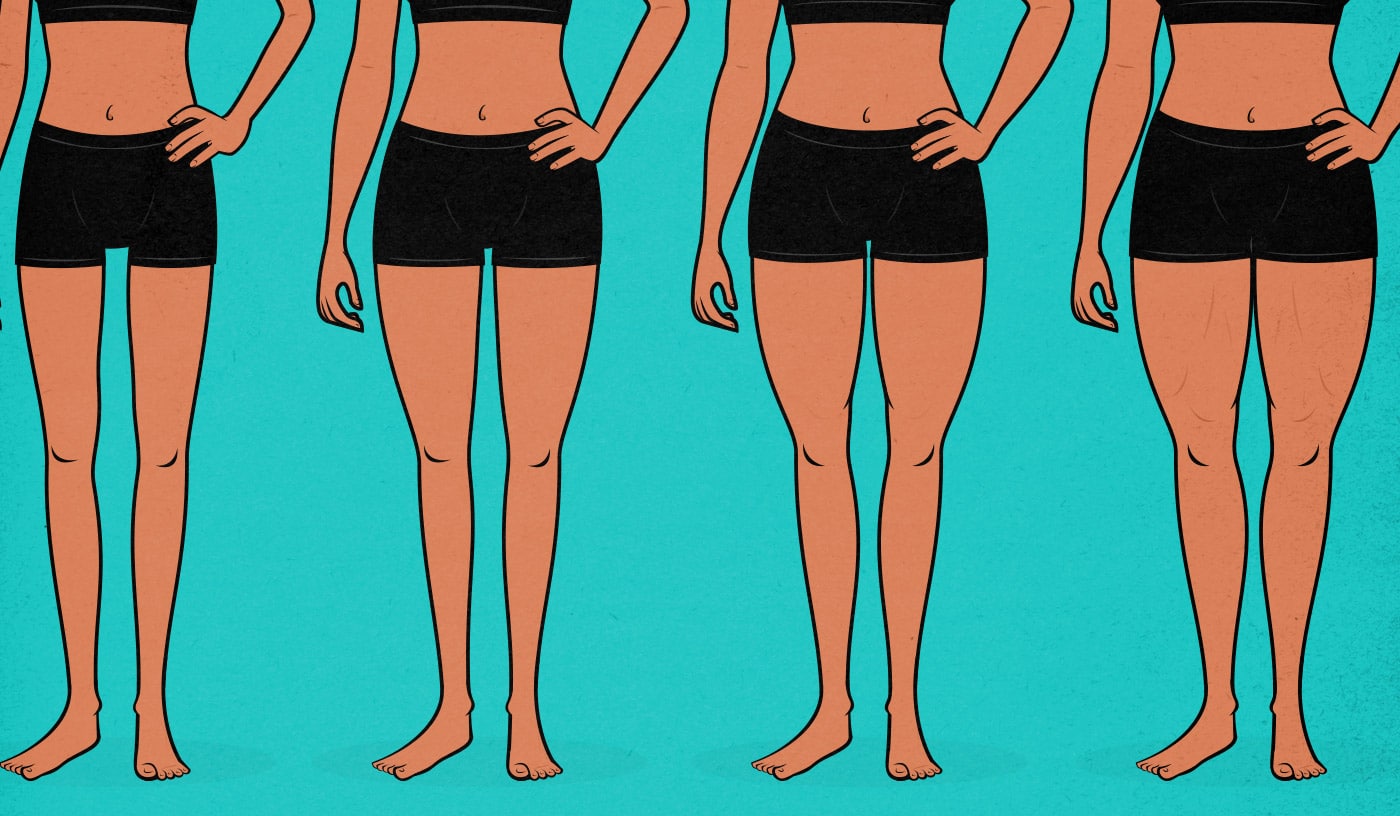
How to Gain Muscle in Your Legs As A Woman
The Importance of Hypertrophy Training For Leg Growth
Hypertrophy training is a type of resistance training that focuses on stimulating muscle growth. Unlike strength training, which is focused on getting stronger for your size, hypertrophy training is focused on muscle size. It’s focused on making you bigger.
A common mistake is to confuse aerobics with hypertrophy training. Aerobic programs are follow-along workout routines where you string together a bunch of light exercises, feeling the burn and getting your heart rate up. That’s cardio, similar to jogging. You can build some muscle that way, but not very much.
Hypertrophy training is more structured. You do one exercise until you cannot do it anymore. You’d grab a dumbbell, do goblet squats, and keep going until your leg muscles are on the cusp of giving out. Then you rest, recover, and do it again. And again. By challenging the strength of your legs, you send a signal to your body that you need bigger leg muscles.
The Best Leg Exercises for Women With Skinny Legs
Here are the best exercises for the different muscles in your legs:
- Quads. This is the front of your thigh. These exercises include squats, leg extensions, step-ups, etc.
- Hamstrings. This is the back of your thigh. These include exercises like Romanian Deadlifts, leg curls, Swiss Ball Leg Curls, etc.
- Calves. These… are your calves. You can do standing calf raises, seated calf raises, and position your toe to hit different muscle fibres.
You don’t want to forget about your glutes, either. Squats and Romanian deadlifts both stimulate your glutes, so you’re already doing twice as much work for your glutes as any other muscle. If you want even more, you could add in the glute bridge or hip thrusts.
How to Create a Leg-Size Workout Plan For Women
To create a leg workout plan as a woman, you need to consider where you’re starting from. A beginner might see rapid leg growth with just a few sets of squats. But a seasoned lifter who’s been in the gym for 5 years will need a lot more volume and a variety of exercises to continue to see growth.
But in general, you should start by selecting a variety of exercises that target different muscles in your legs. Ideally, you start with a heavier compound lift, like a squat or a deadlift variation. Then you can do some isolation work after for more volume, like step-ups, Swiss ball leg curls, or if you have access to machines—exercises like leg curls and leg extensions.
Over time, you can change the load to keep stimulating your legs. Doing 5-rep and 15-rep squats feels completely different and will challenge your legs in different ways. Both of those ways will stimulate muscle growth.
Beginner Leg Workout For Women
The workout is very simple, and we’ll go over the instructions in a moment. Here it is:
- Goblet squats: 2 sets of 10 repetitions.
- Dumbbell Romanian deadlift: 2 sets of 10 repetitions.
- Standing Calf Raises: 2 sets of 10 repetitions.
- Raised push-ups: 2 sets of as many reps as you can do (AMRAP).
- Dumbbell row: 2 sets of 10 repetitions.
- Bonus: Extra glute work like 2 sets of 10 reps of glute bridges or hip thrusts
The workout starts with leg exercises. That way, you’re investing your best effort into stimulating your leg muscles. Later in the workout, you can switch to the upper body for balanced growth.
GET THE free GOOGLE SPREADSHEET OF THE
female BEGINNER’S FULL-BODY with glute targeting WORKOUT
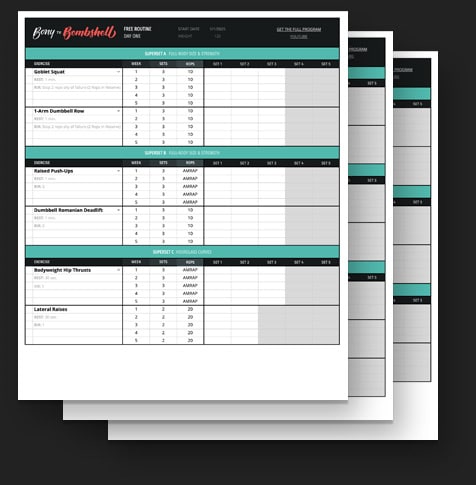
Get the glute targeting workout as a Google spreadsheet. You’ll be able to pick from exercise alternatives, and fill out the sheet.
Plus, we’ll make sure you’re on the Bony to Bombshell newsletter, and send you all of our best women's muscle-building content.
When doing the workout, worry less about the number of reps and more about challenging yourself with the weight you picked and bringing yourself close enough to failure. Whether you fail at 6 or 20 reps, you’ll build muscle either way. Anywhere from 4–40 reps per set is good for building muscle.
Ideally, you’ll stop your set when you’re just about to fail. But as a beginner, knowing exactly how hard you’re pushing yourself is hard. If you aren’t sure if you’re taking your sets close to failure, try doing more. Try pushing yourself all the way until your muscles give out. That way, you’ll know what it feels like. Next time, stop right before that point.
Leg Workout Split For Women
If you really want to challenge your legs, you can also do a split workout. All your leg work will be on one day, giving it a lot of work in just one workout. This introduces another new form of stress. And then we can do a second workout day focusing on your upper body for balanced growth.
GET THE GOOGLE SPREADSHEET OF THE
FREE female BEGINNER’S Lower & Upper dumbbell WORKOUT

Get the workout as a Google spreadsheet. You’ll be able to pick from exercise alternatives and fill out the sheet.
Plus, we’ll make sure you’re on the Bony to Bombshell newsletter, and send you all of our best women's muscle-building content.
Sets: Start With 2, Then Add More
Start with just a couple of sets, then add more as you get stronger. We recommend doing two sets of each exercise in the first week. Practice your form, find the right weights, and take your time.
Next week, if you aren’t too sore at the start of each workout, try adding a set to each exercise. If that goes well and you feel ready for more, add another set next week. You can do around 3–6 sets per exercise. Most people will do best with 3–4 sets (including us). If you ever start to feel worn down, or if you’re coming back after a long break, start the cycle over again, going back to just two sets per exercise.
How Often Should I Do This Workout?
We recommend three full-body workouts per week. That’s enough to maximize your rate of muscle growth, and it also gives you plenty of time to recover between workouts.
Each workout will stimulate muscle growth for the next 2–3 days. After those 2–3 days, your leg muscles will be (mostly) repaired, and you should be ready for another workout. More importantly, you should be stronger. You should be able to lift more weight or eke out more repetitions than last time.
Because each workout stimulates a couple of days of muscle growth, training every second or third day is perfect. Here’s a good default schedule. Feel free to adjust it:
- Monday: Workout 1
- Tuesday: Rest
- Wednesday: Workout 2 (even if sore)
- Thursday: rest
- Friday: Workout 3 (even if sore)
- Saturday: Rest
- Sunday: Extra Rest (to finally banish the soreness)
How Long Should I Rest?
How long you rest between sets isn’t that important. Whether you rest for 2 or 10 minutes, you’ll still stimulate a similar amount of muscle growth. The important thing is that you rest long enough to catch your breath, ensuring that your cardiovascular system doesn’t limit the performance of your muscles.
In general, you can rest for 1-2 minutes between sets. The main reason to rest for just a couple of minutes is to keep your workouts short and dense. But if you need more rest or get interrupted partway through your workout, no problem. Just pick up where you left off.
If you want to blast through your workout even faster, you can do the lifts in a circuit/superset. Do a set of push-ups, rest a minute, then do a set of squats, rest a minute, do your second set of push-ups, and then do your second set of squats. That way, you’re giving your muscles plenty of time to recover between sets, but you’re doing another exercise during the rest period.
Add Isolation Lifts—If You Want
This simple workout is a great foundation for building up the legs, but feel free to add to it. If you want bigger glutes, no problem. You’re already doing squats and a deadlift variation, which is plenty, but there’s no harm in adding extra step-ups, split squats, leg curls, leg extensions, or lunges for extra leg stimulation.
Workout Video Demonstration For Leg Growth:
The Goblet Squat
Here’s Marco and Simone teaching the goblet squat. This is a great lift for building bigger quads and glutes and strengthening your torso and posture. Don’t be discouraged if it takes you a little while to master. You don’t need to be perfect on your first day. Just strive for gradual improvement.
Dumbbell Romanian Deadlift
Standing Calf Raises
Raised Push-Ups
Dumbbell Row
Bonus: Single Leg Hip Thrust For Glute Growth
Diet and Nutrition for Stronger Legs As A Woman
Lifting weights is just the first step. It tells your body you need bigger, stronger legs. But your body needs extra nutrition to build those bigger muscles, so your diet and even things like sleep matter quite e lot when it comes to building stronger legs.
Your leg muscles are big. Even if they’re small right now, they’re still quite a bit bigger than the other muscles in your body. They can grow much bigger. But to build bigger legs, you need to eat enough food to support muscle growth.
Getting Enough Protein
Protein is an essential nutrient for muscle growth. It provides the building blocks for muscle tissue, which is why it’s important to consume enough protein in your diet. Our body uses protein to construct hair, nails, organs, red blood cells, etc.
It’s not just enough to get enough protein to live—you need an abundance of protein, especially after lifting, to help build more muscle mass. In general, we recommend aiming for about 1 gram of protein per bodyweight pound. So if you are 120 pounds (54kg), then you should aim for 120 grams of protein.
To ensure that you’re getting enough protein, include foods such as:
- Unprocessed meats
- lean ground meat (ground beef, ground turkey, etc.)
- steaks
- chicken breast, chicken wings, chicken drumsticks, etc.
- seafood
- eggs
- dairy
- Try Kefir or other fermented dairy, as the probiotics can help with digestion.
- Alternatively some women have anecdotes of unheated dairy with living probiotics and active enzymes helping with digestion.
- Protein powders are more processed but included within a healthy diet, they can help you reach your protein goals.
- Investigate whey isolate, or a vegan protein powder like soy isolate or a rice/pea blend
To a lesser extent, there is still some protein found in beans and legumes, and those can be a helpful ally when it comes to building muscle, as they’re also full of good carbohydrates.
How many calories?
If you’re overweight or skinny-fat, you can use the fat on your body to fuel some muscle growth. If you’re getting stronger every week, you don’t need to worry about eating more food.
However, if you’re thin, you’ll need to get your extra energy from eating extra food. We have a full article on a muscle-building diet for women here.
Conclusion
To build bigger legs, you need to follow a good hypertrophy training program that stimulates your leg muscles, then you need to support muscle growth by eating enough calories and protein. That’s easier said than done, I know. The good news is that it works incredibly well—no matter how thin your legs are!
If you liked this article, you’d love our muscle-building newsletter. We’ll keep you up to date on all the latest muscle-building information for women. Or, if you want us to walk you through the process of building muscle, including teaching you the lifts, giving you a full workout program, a complete diet guide, a recipe book, and online coaching, check out our Bony to Bombshell Program

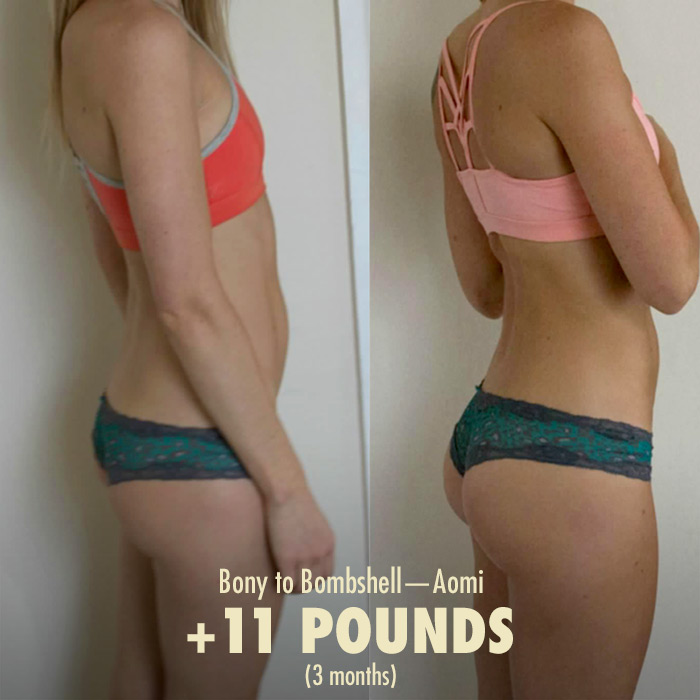
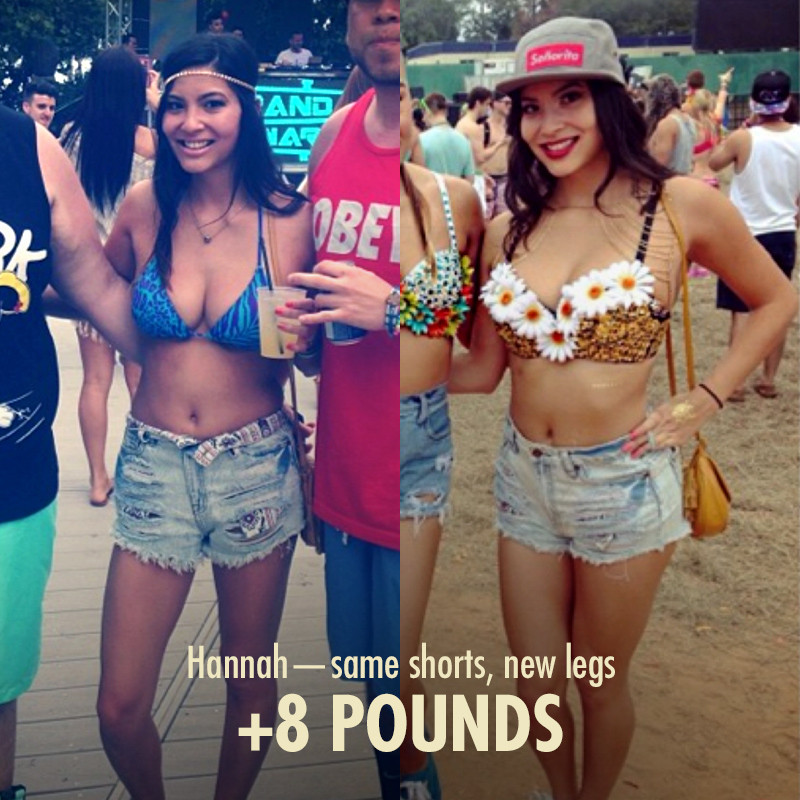
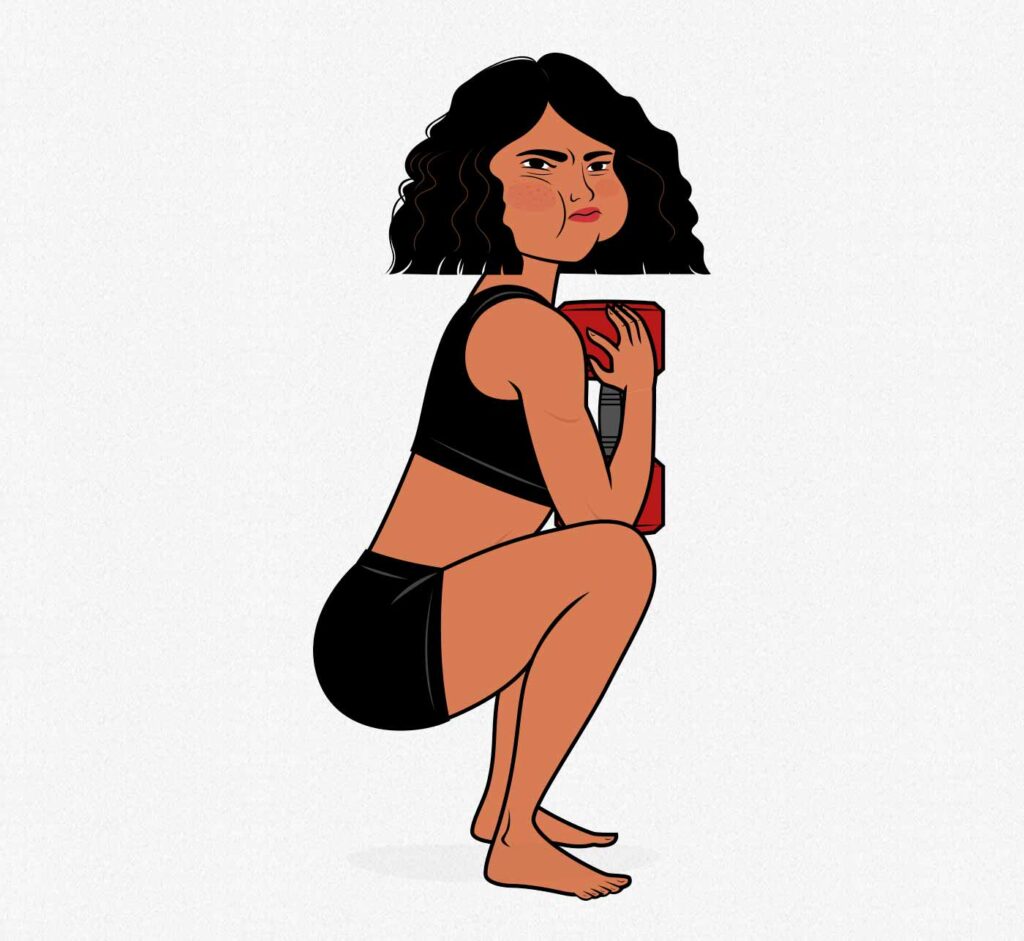

FREE women's Muscle Growth MINI-COURSE
Get our 5-part female bulking mini-course that covers everything you need to know about:
Here are some related articles